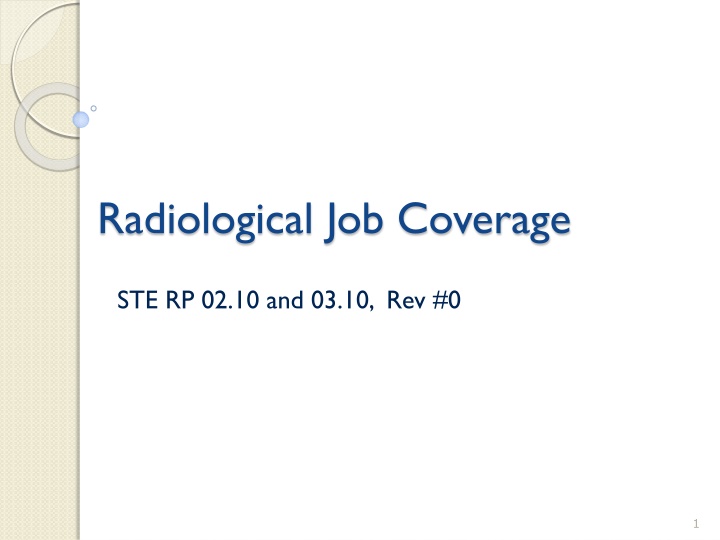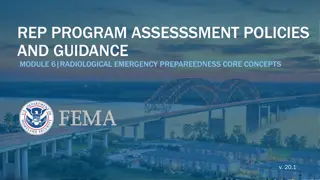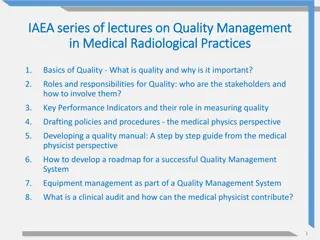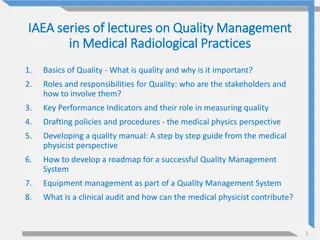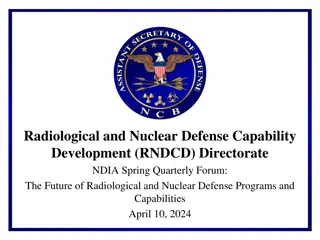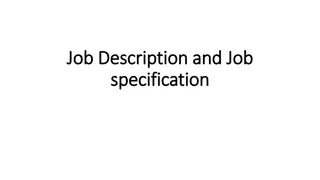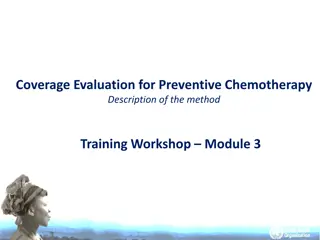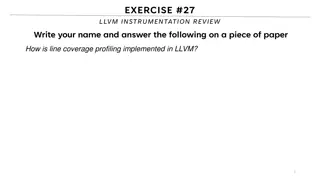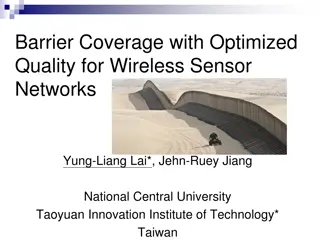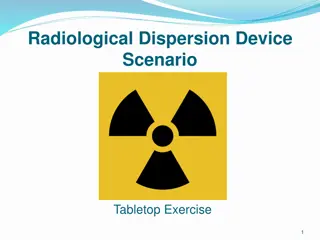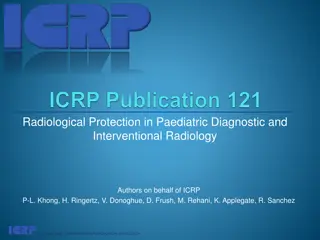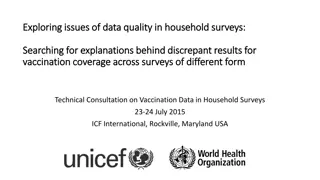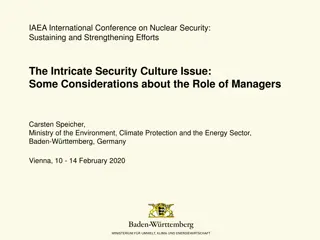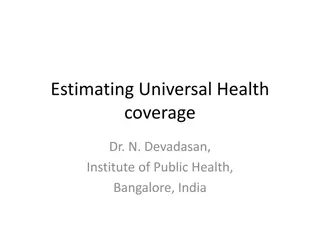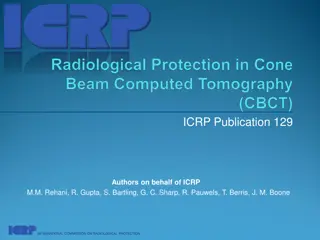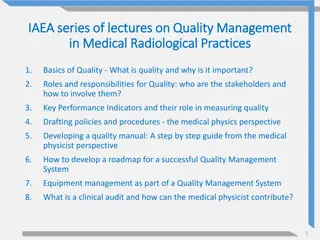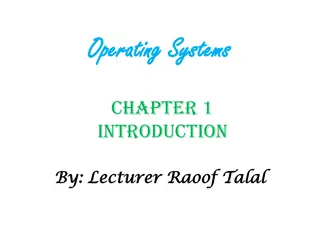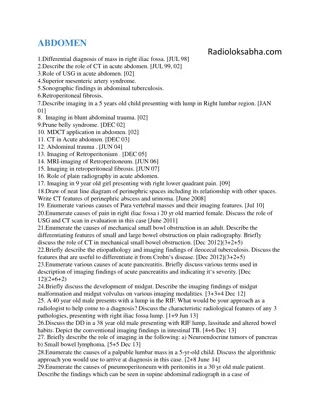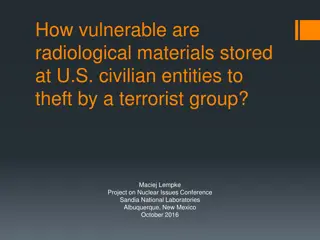Radiological Job Coverage and Operating Experience Review
Explore the importance of proper job coverage in radiological tasks, focusing on a specific incident involving workers entering the wrong location inside a high radiation area. Learn valuable lessons on following procedures, training, and maintaining continuous job coverage to ensure safety. Understand the Terminal Objective of performing low radiological risk job coverage and related Enabling Objectives. Utilize real-world examples to enhance understanding and prevent similar incidents.
Download Presentation

Please find below an Image/Link to download the presentation.
The content on the website is provided AS IS for your information and personal use only. It may not be sold, licensed, or shared on other websites without obtaining consent from the author.If you encounter any issues during the download, it is possible that the publisher has removed the file from their server.
You are allowed to download the files provided on this website for personal or commercial use, subject to the condition that they are used lawfully. All files are the property of their respective owners.
The content on the website is provided AS IS for your information and personal use only. It may not be sold, licensed, or shared on other websites without obtaining consent from the author.
E N D
Presentation Transcript
Radiological Job Coverage STE RP 02.10 and 03.10, Rev #0 1
OPEX When reviewing Operating Experience (OPEX) consider: What Happened? Why did it happen? How can it happen at my work location? What are our barriers? What are the lessons learned? 3
OPEX ICES 420919 Workers Enter Incorrect Location Inside of a Locked High Radiation Area 05-17-2017 EVENT: Four individuals attended a LHRA brief to enter the Drywell and proceed to the bioshield for nozzle inspections. The supplemental RP technician performing the LHRA briefing did not use the LHRA Briefing Form checklist as required by procedure and instead went from memory during the brief. The supplemental RP technician briefed the individuals to an incorrect travel path. The individuals were monitored remotely during the entry with telemetry, communications, and cameras. 4
OPEX ICES 420919 (cont.) EVENT (cont.): The individuals entered the Drywell which is posted LHRA, on the correct Radiation Work Permit (RWP) and with the correct electronic dosimeter set points. The individuals then proceeded to the work location via the travel path briefed to them by the supplemental RP technician. Shortly after arriving at the entrance to the bioshield the individuals entered and began to look for the nozzles to inspect. Within minutes the individuals realized they were in the wrong location. Simultaneously, the Radiation Protection technician providing remote coverage identified the individuals were in the wrong location via camera and directed the individuals to exit the area. Dose and dose rates encountered were within the RWP limits. 5
OPEX ICES 420919 (cont.) Lessons Learned: The individuals were briefed from memory resulting in a travel path to the incorrect location of the nozzles. The brief that was required for the RWP was inadequate. Barriers in Place: Procedures Training Continuous Job Coverage 6
Terminal Objective RP02.10 Given a job coverage task involving sources of radiation and/or radioactive material, PERFORM low radiological risk job coverage in accordance with NISP-RP-10, Radiological Job Coverage. 7
Enabling Objectives RP02.10 From memory and in accordance with NISP-RP-10, students will: 1. Describe techniques used to reduce radiation exposure, including prefabrication, shielding, special tools, engineering controls, and decontamination. 2. List the requirements for entry into various areas in the plant. 3. Describe the different levels of job coverage. 4. Explain what actions should be taken when monitoring and controlling discrete radioactive particles. 5. List when DAC tracking is required for airborne radioactivity areas. 6. Describe the radiological surveys required for various scenarios. 8
Enabling Objectives RP02.10 From memory and in accordance with NISP-RP-10, students will: 7. List the actions to be taken upon completion of radiological work coverage. 8. Describe the requirements for non-standard dosimetry use and placement. 9. Recall techniques for controlling exposure to beta radiation. 10. Explain methods to keep worker and station dose ALARA. 11. Calculate estimated neutron dose when given a mixed neutron and gamma dose rate field. 12. Describe shielding principles, including installation and removal. 9
Enabling Objectives RP02.10 From memory and in accordance with NISP-RP-10, students will: 13. State the importance of using body shield vests properly, including precautions and limitations. 14. Explain the responsibility of the RP Technician when covering work, including use of Stop Work Authority. 15. Identify potential warning signs that a radiological incident may occur or is in progress. 16. Recall the expected response to a radiological incident. 10
Terminal Objective RP03.10 Given a job coverage task involving sources of radiation and/or radioactive material, PERFORM medium or high radiological risk job coverage in accordance with NISP-RP- 10, Radiological Job Coverage. 11
Enabling Objectives RP03.10 From memory and in accordance with NISP-RP-10, students will: 1. Describe prejob radiological survey requirements and follow-up actions. 2. Describe how the results of ALARA reviews are implemented. 3. Explain the factors that determine the need for and type of respiratory protection equipment to be used during radiological work. 4. Explain how to determine the type and location of whole-body dosimetry. 5. Identify the criteria that determine the need for multiple badging or extremity monitoring. 12
Enabling Objectives RP03.10 From memory and in accordance with NISP-RP-10, students will: 6. Identify measures that may be taken when using protective clothing in potential heat stress conditions. 7. Describe the process of continuous job coverage, including the use of remote monitoring equipment. 8. Discuss proper job coverage and radiological protection measures for high-exposure jobs and potential high-exposure jobs. 13
NISP RP 10, Radiological Job Coverage The following diagram shows the key elements in providing job coverage. Arrows are provided to show the relationships among key elements. Section 3.1 Section 3.2 Survey Work Areas Section 3.3 Section 3.4 Prepare for Job Coverage Monitor & Verify Protective Measures Respond to Unexpected Conditions Review Job Requirements, Rad Information, & Status Verify Conditions Are Consistent with RWP Bases Verify Worker Practices Meet Expectations Coach Workers Verify Contamination Control Measures Are Effective Implement Corrective Actions & Notify RP Supervision Verify Postings Correct for Work Obtain Turnover Inform Workers on Conditions & Expectations Stop Work if Dose Alarm or Unplanned Dose Rate Alarm Occurs Verify Adequacy of Dosimeter Alarm Setpoints Attend Prejob Briefs Ensure Instruments and Materials are Available Verify Dosimetry Placement is Correct Stop Work Before Unplanned or Unmonitored Dose Occurs Notify RP Supervision Verify Protective Measures are Implemented Consistent with Hazards 14
Radiological Job Coverage Actions to be taken in preparation for radiological job coverage. Obtain a turnover and/or a prejob brief to review the following information that may be applicable: Most recent radiological surveys. RWPs and allowed scope of work. ALARA Plans. RP logs. Condition Reports. Review job coverage requirements on the applicable RWP and ALARA Plan 15
Radiological Job Coverage Determine coverage requirements consistent with RWPs and ALARA Plans, conditions, and work to be performed (e.g.) Continuous v. Intermittent Coverage Stay times Discrete Radioactive Particles (DRPs) Dose gradients PPE requirements Survey frequency Liquid abatement / control Shielding requirements Air sampling requirements and strategy Changing conditions Alpha Area considerations Are alpha emitters present? Will the work likely introduce alpha emitters? Additional needed controls? Notify RP supervision if a discrepancy is apparent. 16
Radiological Job Coverage Obtain face-to-face turnover when relieving for continuous job coverage. Communicate with workers in prejob briefs and during job coverage to ensure they understand radiological conditions, protective requirements, and work restrictions. PPE requirements Remote monitoring Body positioning Dose gradient Hot spots Streaming Dosimetry Telemetry Multi-Badging Extremity monitoring Neutron monitoring Diving monitoring 17
Radiological Job Coverage Ensure the equipment is available, calibrated, source checked and operational as needed to perform surveys and collect air samples. Dose rate meter Contamination meter Frisker Large area smears, nu-con swipes Scaler Equipment for tritium sampling Air Sampler Filters particulate, iodine, noble gas Sampler head Tubing Positioning of pump exhaust Lapel samplers 18
RP02.10 Objective 1 Describe techniques used to reduce radiation exposure, including prefabrication, shielding, special tools, engineering controls, and decontamination. Basic principles for reducing radiation exposure are: Decrease time in a dose field Increase distance from radiation source Increase shielding between personnel and radiation source Decrease source activity 19
RP02.10 Objective 1 Decrease time in a dose field: Plan the work, work the plan Use mock-ups Use experienced personnel Only required personnel in the work area Set-up, assemble and prefabricate equipment to the extent practical before going to the work area Stay in low dose areas unless necessary 20
RP02.10 Objective 1 Increase distance from radiation source: Use long handled reach tools Work equipment at arms distance instead of close to body Use robotic manipulators Use remote monitoring as possible Stay in low dose areas unless necessary Evaluate is equipment can be moved to a low dose area 21
RP02.10 Objective 1 Increase shielding between personnel and radiation source: Work behind installed shielding Evaluate for increasing permanent shielding Use temporary shielding on components Use shield walls around a work area Ensure work groups do not move or remove shielding without proper authorization 22
RP02.10 Objective 1 Decrease source activity: Flush process lines with clean water Decontaminate equipment to be worked Decontaminate work area Decontaminate or cover surfaces that will be contacted Remove source term from work area 23
RP02.10 Objective 2 List the requirements for entry into various areas in the plant. Entry into radiological areas is governed by RWPs, ALARA Plans, and Plant procedures and requirements. Typical requirements for entry into a Radiologically Controlled Area are: Dosimeter of Legal Record DLR Self Reading Dosimeter SDR Radiological Work Permit RWP 24
Contaminated Areas Protective measures to be implemented for work in Contaminated Areas. Monitor worker practices and contamination levels to determine if protective actions are sufficient to prevent worker intakes, personnel contamination and the spread of contamination. Notify RP supervision if protective actions may need to be reassessed. Personnel can track contamination to clean areas after leaving a contaminated area. Protective measures include: Ensure a frisker, hand and foot monitor, or a whole body contamination monitor is in close proximity to the Contaminated Area. 25
Contaminated Areas Contamination can potentially pass through coveralls if rubbed on surfaces > 10,000 dpm/100 cm2. Protective measures may include one or more of the following: Place clean coverings on the contaminated surface. Wear knee and/or elbow pads. Wear coveralls made of a material that mitigates the potential for pass through. Use work practices to avoid contact with contaminated surfaces. Decontaminate surfaces that will be contacted. 26
Contaminated Areas Contamination may pass through the clothing due to contact with contaminated water or clothing becomes saturated with sweat. Protective measures may include one or more of the following: Wear clothing that does not absorb water such as plastic or a similar material. If heat exposure and the scope of work limit the use of specialized clothing to prevent skin contamination, protective measures may include: Use air supplied suits to keep the body cool during work. Wear ice vests under the protective clothing. Limit stay times to prevent coveralls from becoming too saturated. Perform an evaluation to determine if the potential risks from skin contamination are acceptable. 27
Contaminated Areas Contamination can become airborne when welding, burning, or grinding surfaces. Protective measures may include one or more of the following: Set up ventilation and/or containment structures to isolate any airborne contamination that occurs. Isolate and post the area potentially affected as an Airborne Radioactivity Area and restrict access. Require the use of respiratory protection in potentially affected areas. Establish a regime for obtaining air samples representative of worker breathing zones and to determine the boundaries of airborne radioactivity. 28
Contaminated Areas Contamination can spread to clean areas when removing Items from contaminated areas. Protective measures may include: Instructing workers to transfer items to clean plastic bags and take the items immediately to an RP technician who will survey, bag, and tag the items per NISP-RP-04, Radiological Posting and Labeling. Provide RP support to survey a large item while in the Contaminated Area and then transfer the large item to a clean plastic sheet or box type container outside the Contaminated Area using lift equipment providing direction to: Provide direction on wrapping or boxing the item without spreading contamination. Exercise precautions to survey and/or decontaminate lifting equipment. Ensure the container is labeled per NISP-RP-04, Radiological Posting and Labeling. 29
High Contamination Areas Protective measures to be implemented for work in High Contamination Areas. Concerns and protective measures for work in a High Contamination Area where the extent and magnitude of the contamination levels require additional protective measures beyond those of a Contaminated Area. Follow RWP and ALARA plans for work in High Contamination Areas Same concerns exist as for a Contaminated Area. Employ the same protective measures. 30
High Contamination Areas Dry loose surface contamination can become airborne from wind currents or simply walking or rubbing the surface. Protective measures may include one or more of the following: Keep surfaces wet. Set up HEPA ventilation equipment to contain any airborne radioactivity. Use a fixing agent on surfaces such as paint or an adhesive. Cover the high contamination with oil cloth or equivalent material. Maintain the integrity of boundary walls or structures to isolate the airborne radioactivity. Wear respiratory protection while in the area as determined by a TEDE ALARA evaluation. Control ventilation flow rates and direction. Decontaminate the surfaces to lower the removable contamination levels. 31
High Contamination Areas Contamination on protective clothing may not be easily contained when exiting the area. Protective measures may include one or more of the following: Contain the high contamination to a small area, e.g. the internal surface of a system component, by wiping down or changing gloves that contact highly contaminated surfaces before contacting surfaces with lower contamination levels. 32
High Contamination Areas Contamination on protective clothing may not be easily contained when exiting the area. Protective measures may include one or more of the following (cont.): Establish a two step-off-pad (SOP) arrangement to remove highly contaminated outer protective clothing prior to traversing to the next SOP to remove the remaining protective clothing. Consider the following when evaluating the use of two SOPs: Maintain a sufficient distance, if available, between the SOP from the High Contamination Area to the SOP for the Contaminated Area to provide containment and routine decontamination in the Contaminated Area. Instruct workers to wear two sets of outer boots, two pairs of coveralls, and two sets of rubber gloves. 33
High Contamination Areas Contamination on protective clothing may not be easily contained when exiting the area. Protective measures may include one or more of the following (cont.): Establish a two step-off-pad (SOP) arrangement to remove highly contaminated outer protective clothing prior to traversing to the next SOP to remove the remaining protective clothing. Consider the following when evaluating the use of two SOPs (cont.): Instruct workers to exit the High Contamination Area by removing, in order, the outer gloves, the outer coveralls, and the outer boots, stepping on the SOP while removing each outer boot. The process for removing protective clothing at the next SOP is the same as taught in radiation worker training. If sufficient room is not available for a two SOP arrangement, decontaminate the area where the protective clothing is removed at a frequency that prevents the spread of contamination outside the posted boundary. 34
High Contamination Areas Removable contamination on items removed from High Contamination Areas may be difficult to contain. Protective measures may include: Wipe down or decontaminate the items inside the High Contamination Area to acceptable contamination levels before they are taken across the boundary to the Contaminated Area. The item can then be removed using normal practices for Contaminated Areas. Use double containers; remove the item to a container in the Contaminated Area and then remove that container outside the Contaminated Area into a container that is clean on the outside. 35
Alpha Areas Protective measures and risk levels for work when transuranic nuclides are present at levels that can contribute to a total committed effective dose equivalent (CEDE) greater than 100 mrem. Mixtures of transuranic nuclides are difficult to evaluate because DAC values are 3 or 4 orders of magnitude less than corrosion and fission products and the gamma spectroscopy systems at power plants are not designed to accurately quantify activities of transuranic nuclides. 36
Alpha Areas The radiological risk of work involving transuranics may be classified as having high or medium radiological risk as follows: Entry into or work in an Alpha Level 3 Area is classified as high radiological risk. Work in an Alpha Level 2 Area is classified as medium radiological risk. Abrasive or aggressive mechanical action on surfaces with any potentially fixed transuranics is classified as medium radiological risk. ALARA planning tools and/or the RWP should specify the applicable protective measures. Activity Ratio ( / ) Designated Level > 30,000 Level I (Minimal) 30,000 to 300 Level II (Significant) < 300 Level III (Elevated) 37
Alpha Areas The presence of transuranic nuclides in surface contamination must be measured to understand the potential dose from worker intakes. For protective measures, Alpha Level 1, 2, and 3 Areas are posted per NISP- RP-04, Radiological Posting and Labeling. Contamination surveys are needed during job coverage to verify that the transuranic hazards have been properly evaluated. Protective measures include analyzing smears for alpha emitters per NISP-RP-02, Radiation and Contamination Surveys. If a work area has not been characterized properly and the transuranic hazard is greater than posted, the take the following actions: Notify RP supervision. Determine if established radiological controls are adequate to prevent unplanned worker dose and, if not, stop work. 38
Alpha Areas Worker intakes of transuranics cannot be measured using plant equipment for in vivo bioassays. Protective measures to monitor for potential intakes require the use of personal air samplers unless appropriate alternatives are specified in the RWP. Personal air samplers are used per NISP-RP-03, Radiological Air Sampling to identify when in vitro bioassays may be needed. Worker intakes of transuranics cannot be measured using plant equipment for in vivo bioassays. Protective measures to monitor for potential intakes require the use of personal air samplers unless appropriate alternatives are specified in the RWP. Personal air samplers are used per NISP-RP-03, Radiological Air Sampling to identify when in vitro bioassays may be needed. 39
Alpha Areas Transuranics may be embedded in lower oxide layers inside piping and components due to fuel failures during earlier fuel cycles. Smears may not collect the transuranics when the system is breached. Protective measures include the following: Plant RP staffs are responsible for characterizing plant areas and systems based on the presence of transuranics and historical fuel performance. Plant RP staffs are responsible for identifying when work will be performed in an Alpha Level 2 Area or Alpha Level 3 Area. Use respiratory protection and lapel air samplers per NISP-RP-03, Radiological Air Sampling when performing aggressive work, e.g. grinding, that could disturb lower oxide layers containing transuranics. 40
Alpha Areas The potential internal dose from transuranics in plant contamination mixtures increases in proportion to the corrosion and fission products as the mixture decays. Protective measures require periodic monitoring of / ratios to ensure areas are properly posted and evaluated for potential internal dose if surface contamination becomes airborne. NISP-RP-02, Radiation and Contamination Surveys and NISP- RP-03, Radiological Air Sampling provide instructions for determining / ratios. Equipment and materials removed from areas with transuranics may be handled outside the posted Alpha Level Area. As a protective measure, ensure equipment and materials removed from an Alpha Level 3 are packaged and labeled to alert personnel handling the package that significant transuranic contamination may be present. Labeling requirements are described in NISP-RP-04, Radiological Posting and Labeling. 41
Alpha Areas The abundance of transuranic nuclides can be high enough to result in unplanned intakes if personnel and materials are not monitored for alpha radiation. Protective measures include: Require personnel to frisk using an alpha detector when exiting an Alpha Level 3 area where the / ratio is 50. Segregate equipment and materials that have been exposed to contamination with a / ratio 50 until surveys can be performed to release an item from alpha controls. Ensure postings for areas with a / ratio 50 contain the insert Alpha Frisking/Monitoring Required Upon Exit per NISP-RP-04, Radiological Postings and Labeling. 42
Airborne Radioactivity Areas Protective measures to be implemented when workers may be exposed to airborne radioactivity. Potential causes of airborne radioactivity include the following: - System leakage - Breaching a system component - Agitating a contaminated surface, i.e. grinding, welding, scrubbing, hammering, etc. - Air flow over a highly contaminated surface 43
Airborne Radioactivity Areas Respiratory protection may be used to prevent worker intakes. Requirements for using respiratory protection equipment are provided in the radiation work permit. The maintenance and use of respiratory protection equipment are not included in the standardized tasks for supplemental RP personnel; plant procedures govern these activities. Knowledge requirements for the use of respiratory protection are included in orientation training. A planned exposure to airborne radioactivity without respiratory protection may be allowed if a supporting evaluation concludes the Total Effective Dose Equivalent (TEDE) will be lower due to increasing the work efficiency of a worker, i.e. wearing respiratory protection will increase the external dose to the worker causing the TEDE to be higher as compared to the TEDE without respiratory protection. These evaluations are not included in the standardized tasks for supplemental RP personnel; plant procedures specify how these evaluations are performed. 44
Airborne Radioactivity Areas NISP-RP-03, Radiological Air Sampling specifies when air samples are needed, how to evaluate results, and when stop work authority should be exercised. 45
Airborne Radioactivity Areas Work controls should be implemented to minimize the potential for worker intake by using process and engineering controls that negate the need for respiratory protection. Process and engineering controls may include one or more of the following: Decontaminating surfaces to reduce the potential for airborne radioactivity. Install a containment device such as a glove bag. Use portable ventilation to pull airborne radioactivity through a HEPA filter and prevent airborne radioactivity in a worker s breathing zone. Maintain surfaces wet to minimize the potential for contamination to be suspended in the air. Spray adhesive on a surface to prevent contamination from becoming suspended in the air. Use oil cloth or equivalent material in a work area to prevent contamination from becoming suspended in the air. Maintain highly contaminated surfaces covered to prevent air flow over the surface. 46
Airborne Radioactivity Areas Use respiratory protection as specified on radiation work permits and in compliance with plant procedures and the applicable TEDE ALARA evaluation. Use DAC-Hour tracking when personnel enter areas with 0.3 DAC without respiratory protection. DAC-Hours may be calculated using personal air sample results. DAC-Hours may be calculated using work area air samples and the measured stay time for each worker. Use plant-specific forms when recording air sample results and stay times of workers. 47
RP02.10 Objective 3 Describe the different levels of job coverage. DEFINITIONS Continuous Job Coverage: Continuous coverage does not necessarily mean continuous presence of the radiological protection technician at the work site; rather, it means one or more technicians are given sole responsibility to cover a job. Remote camera surveillance, effective audio communication with the work area, and telemetry can be used to provide continuous coverage and minimize the dose to job coverage technicians. Intermittent Job Coverage: Intermittent coverage means a job coverage technician may be assigned several jobs to monitor and periodically monitors each activity in progress to provide support as needed. 48
RP02.10 Objective 3 The lead job coverage technician and supporting technicians are responsible for the following: Ensure technicians assigned to track stay times continuously provide full attention to stay time tracking without ancillary duties other than tracking worker dose using stay time tracking, telemetry, and/or remote monitoring Establish a means of communication when required for the following: Instructing a worker to exit an area when approaching a stay time. Informing a worker of accumulated dose when protective clothing requirements or multi-badging prevents the worker from periodically reading issued dosimetry. Informing a worker when body positions are causing increased dose. 49
RP02.10 Objective 3 The lead job coverage technician and supporting technicians are responsible for the following (cont.): Perform timely surveys when contaminated systems are breached to assess: Contamination levels on exposed surfaces, including the presence of transuranics as required. Shallow and deep dose rates from the exposed surfaces. Airborne concentrations, including the presence of transuranics as required. Potential exposure to discrete radioactive particles. Identify work activity evolutions that present a potential for airborne radioactivity and obtain air samples as needed to comply with this procedure and NISP-RP-03, Radiological Air Sampling. 50
